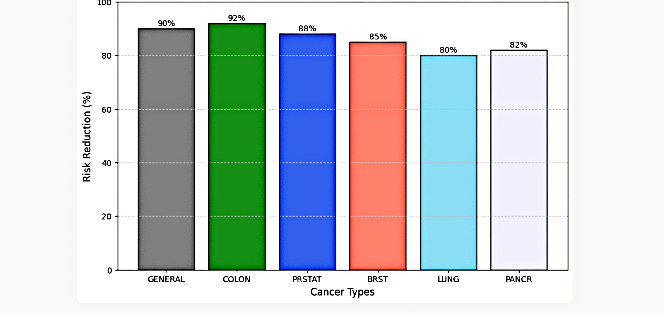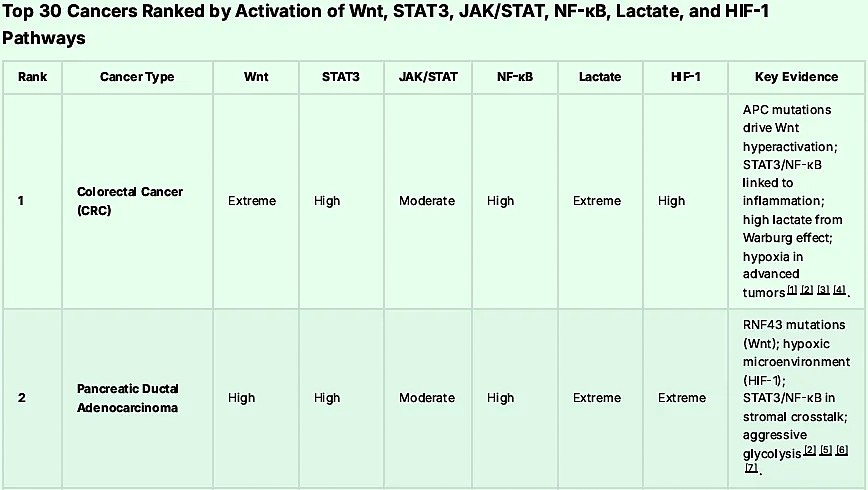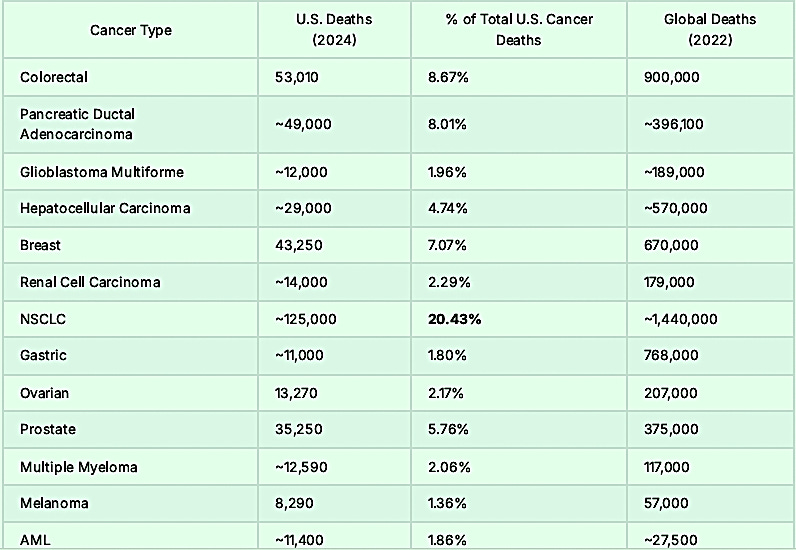The Daily Pills that Stop [Spike-Induced] Cancer
AI Reverse Engineers a Solution to the Spike Protein & Turbo Cancers
The COVID-19 Spike Protein, whether derived from the virus or vaccine is toxic and associated with a host of pathologies including oncogenesis. Today we derive a cocktail of nutraceuticals and repurposed drugs that can block this. As Dr. Peter Parry and colleagues stated,
We have presented significant evidence that the spike protein is pathogenic. This applies when it is part of the virus, when it is free but of viral origin, and when it is produced in ribosomes by the mRNA of the mRNA and adenovector DNA COVID-19 vaccines. Pathophysiological mechanisms of action of the spike protein continue to be elucidated.
Dr. Parry continued,
Cancer—although not definitely proven to be caused by the vaccines—seems to follow vaccination closely and we have reviewed possible causes in the form of spike protein interactions with transcription factors and cancer suppressor genes.
Cancer is the Product of Cancer Stem Cells and Disordered Metabolism
As Dr. Paul Marik and I recently published, cancer is related to stimulation of Cancer Stem Cell Pathways on the one hand, and Metabolic Reprogramming on the other.
The ROOT4™ and ROOT6™ protocols were designed to provide a daily nutraceutical cocktail that offered some protection from developing cancer in those at average to moderate risk. For patients at extreme risk - those with genetic predispositions - we added three repurposed drugs to arrive at the ROOT9™ Protocol.
Since the Spike Protein has been established as oncogenic, Dr. Marik and I decided to design a specific protocol that would focus on targeting Spike-Protein related cancers, and we anticipated this might generate a different combination of agents than those contained in the basic ROOT™ protocols.
Today, we refine our ROOT™ Protocols a step further and focus on Cancer Stem Cell Pathways and Metabolic Reprogramming caused by the Spike Protein.
We employ AI’s assistance in reverse engineering the molecular and cancer stimulating pathways most activated by the Spike Protein to reach an ideal Spike antidote cocktail, one that, mechanistically speaking, should suppress Spike-induced cancers. Additional confirming clinical studies are necessary. However, in view of the recent increase in serious and aggressive cancers, a careful risk/benefit analysis might establish this as a useful tool in the interim.
Spike-induced malignancies pose an increasing cancer risk to a majority of the world’s population if the current trend in escalating aggressive cancer diagnoses should continue.
The Spike Protein’s Most Active Cancer Stem Cell Pathways
Let us begin by first establishing the CSC pathways most activated by Spike. The pathways below are more highly activated by Spike than the lesser stimulated pathways. In other words, NF-KB is by far the most activated. STAT3, JAKSTAT and WNT are all highly activated. Hedgehog, Notch and TGF beta are minimally activated.
This gives Spike a CSC pathway “signature” which is important, as through the process of reverse engineering, we can identify repurposed agents that preferentially “block” or highly suppress these stimulated pathways, thereby neutralizing the increased cancer risk from the Spike Protein.
The Spike Protein disproportionately activates pro-inflammatory (NF-κB, STAT3/JAK-STAT) and pro-viral (Wnt) pathways, while suppressing antioxidant (NRF2) defenses.
Dr. Marik also recently noted - via personal communication - that Spike Protein activates NF-kB which in turn promotes cancer.
Patra, et al, demonstrated that the full-length spike, through the downregulation of ACE2 expression, promoted an angiotensin II type I receptor (AT1R) mediated signaling cascade, induced the transcriptional regulatory molecules nuclear factor-kB (NF-kB) and activation, and increased interleukin 6 (IL-6) levels in epithelial cells. NF-kB activation in cancer cells promotes proliferation, chemoresistance, and invasion, whereas in the tumor microenvironment, it stimulates angiogenesis and immune suppression, collectively supporting the metastatic process.
In addition, the Spike Protein induces metabolic changes that favor the Warburg Effect, or cancer metabolism.
Spike Protein Activates the Warburg Effect via HIF-1 and Lactate Production
Conditions or toxins that promote glycolysis or fermentation over aerobic metabolism favor the development of cancer. The Power Plant article discusses how this works here.
The Spike protein unfortunately promotes cancer metabolism through reprogramming of the mitochondria. The abnormal metabolic pathways most highly activated by Spike are listed below. Two pathways, Lactate and HIF-1, are more highly activated than HK2 or Glut1 and the activation of the Lactate Pathway is extreme. In terms of reverse engineering, we can now target the Lactate Pathway with a nutraceutical of repurposed drugs that “extremely” suppresses this pathway to neutralize.
Lactate is most strongly activated due to spike-driven glycolytic shifts and LDHB inhibition.
HIF-1 is critical for inflammation and glycolysis but secondary to lactate.
Glut1 and HK2 show moderate activation via indirect metabolic demands or HIF-1 signaling.
Top 30 Ranked Spike-Protein Driven Cancers
Here we arrive at the cancers most strongly activated by Spike Protein. To do so we add the pathways contained in our two lists:
#1. Top Spike Activated CSC Pathways:
WNT
STAT3
JAKSTAT
NF-kB
#2. Top Spike Activated Metabolic Reprogramming Pathways:
Lactate
HIF-1
Next, I asked AI to rank the cancers most activated by these six pathways: WNT, STAT3, JAKSTAT, NF-kB, Lactate, and HIF-1. These are the customized cancers most likely to be caused by stimulation of these six Spike Protein Signature pathways in order, from most to least.
The Top Three Spike Related Cancers:
#1. Colon Cancer
#2. Pancreatic Cancer
#3. Glioblastoma
I do not believe it is a coincidence that we are seeing Colon Cancer develop in 25- to 30-year-olds following mass vaccinations with mRNA that produces Spike Protein. Typically, it takes 20 to 30 years for a colon adenomatous polyp to progress from benign to cancerous. Today we notice this occurring in less than 5 years. I believe the Spike Protein Pathway activation can explain this as there is little else that can.
I believe this also explains the explosion in Glioblastoma and Pancreatic Cancer Cases as these are all “Spike Protein Signature” cancers.
Cancers Targeted by Spike Protein Comprise 85% of All Cancer Deaths:
Now I asked AI to estimate the percentage of cancer deaths from the above stimulated cancers. It turns out these 30 cancers traditionally account for 85% of all American cancer deaths.
With the Spike Protein now pouring the proverbial gasoline on the pathway activation fires of these 30 cancers, I was shocked as these deaths approached 90% of all cancer deaths, a number closely linked to purported depopulation efforts.
In Search of a Spike Protein Antidote: The ROOT9™ Protocol Resurfaces
While searching for Spike Stimulated Cancers and repurposed drug solutions for the same, we encounter a shocking result, and that involved coming back around full circle to the ROOT™ protocols.
The end result of today’s extensive Spike Protein Cancer analysis was arriving at ROOT9™ by a different method. And that was by reverse engineering Spike-Related Cancers with AI’s help. You will understand what I mean at the conclusion.
Ranking the Top 12 Agents that the Block Spike-Protein Cancer Pathways
Recall the Spike Protein Cancer Activation Pathways:
#1. Top Spike Activated CSC Pathways:
WNT
STAT3
JAKSTAT
NF-kB
#2. Top Spike Activated Metabolic Reprogramming Pathways:
Lactate
HIF-1
Ranking the Repurposed Agents that Block Spike Pathways:
So, adding these pathways together once again produces those most stimulated by Spike which are: WNT, STAT3, JAKSTAT, NF-kB, Lactate, and HIF-1. I asked AI a simple question. Consider 26 nutraceuticals and repurposed drugs from a list and rank them from most suppressive to least in the above six pathways. And I now discuss AI’s answer with respect to the top 12 agents.
Let us begin with the compounds ranked #10 through #12.
Recall that Mebendazole is included in the ROOT9™ protocol for preventing cancer. Vitamin D is a key component of the ROOT6™ all-nutraceutical protocol. Fenbendazole, while similar in safety and efficacy to Mebendazole, is not FDA approved for use in humans. Mebendazole plays a crucial role in blocking cancer metabolism through lactate suppression and WNT pathway inhibition.
Mebendazole:
Wnt: High (induces TNIK degradation, blocking Wnt/β-catenin signaling in colorectal cancer).
HIF-1: High (reduces HIF-1α/2α and HIF-1β protein levels under hypoxia).
NF-κB: High (downregulates p-IKKα/β and p-NF-κB via Girdin/Akt axis).
STAT3/JAK-STAT: Moderate (reduces IL-6/STAT3 signaling in ovarian cancer).
Lactate: Moderate (inhibits HK1, GAPDH, and LDHA, reducing ATP production).
Vitamin D:
Keep in mind Vitamin D’s high suppressing activity which can reverse the Spike Protein’ activation of the NF-kB pathway, which as you recall from the first section - according to Dr. Marik - was associated with proliferation, chemoresistance, invasion, angiogenesis and immune suppression. Although AI ranks Vitamin D at #11, Dr. Marik and I would rank it in the top four.
NF-kB activation in cancer cells promotes proliferation, chemoresistance, and invasion, whereas in the tumor microenvironment, it stimulates angiogenesis and immune suppression, collectively supporting the metastatic process.
Moreover, Vitamin D powerfully suppresses inflammation through NF-kB. Now for those agents ranked by AI at # 7 through # 9.
Omega 3, Quercetin and Sulforaphane all have high inhibiting activity against NF-kB, the most important Anti-Spike pathway.
Sulforaphane:
STAT3/NF-κB: Inhibits STAT3 phosphorylation and NF-κB via IKK suppression
Quercetin:
STAT3: Blocks IL-6-induced STAT3 activation.
Omega-3:
NF-κB: High: DHA demonstrates selective NF-κB inhibition in malignant prostate cells.
Wnt: Moderate: Inhibits MMP-2 through decrease of STAT3 and β-catenin in GBM cells.
Lactate: Moderate (alters glycolysis via lactate shuttle regulation).
STAT3: Suppresses in hepatocellular models.
Now we move on to the agents AI has ranked #4 through #6.
Celecoxib is contained in our ROOT9™ protocol. And studies have shown it powerfully suppresses Colon Cancer, the # 1 Spike-stimulated malignancy. Ivermectin powerfully suppresses the NF-kB pathway and to some degree inhibits all six of our CSC pathways. Resveratrol complements the others by blocking metabolic reprogramming through HIF-1 suppression.
And now we move on to the top three, the Anti-Spike agents ranked #1 through #3. Here is where the big surprises come.
The agent ranked at #1 is so powerful it could function as a stand-alone monotherapy as it blocks each and every one of the Spike-Stimulated pathways with either “extreme” or “high” efficacy. And it is neither Ivermectin, Mebendazole or Fenbendazole.
It is the agent that returns us full circle to the ROOT9™ Protocol that is now applicable to Spike-Related Cancer Suppression. And it is the single most important agent that I advise virtually every adult alive to take as it just may save you from contracting Spike-related cancer.
Keep reading with a 7-day free trial
Subscribe to Repurposed Drugs: Powers & Possibilities to keep reading this post and get 7 days of free access to the full post archives.
























